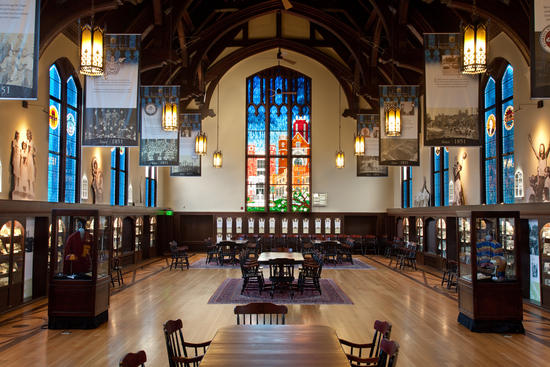Note: this two-part post about teaching a course on “Religion and Law in America” was co-written with Charlie McCrary and originally appeared on the Religion in American History blog.
**
While there is no shortage of avenues to explore religion and law, we decided to focus this semester’s course on the theme of pluralism. There is no better idea through which to explore the contradictions of American jurisprudence on religion. We also started the course with a guiding question: “How did we get here?” That is, to take one recent example, how did American religion law reach a point where closely held corporations can successfully claim First Amendment rights to free exercise of religion?
We began with Hobby Lobby, a case that made headlines this summer. On the first day we assigned Winnifred Sullivan’s excellent piece on the decision (which was not, through a great feat of humility and restraint, titled “I Told You So”). One of the arguments we will be making in the course is that the First Amendment has always been caught in a torturous contradiction: empowered to protect all religious expression while selectively, strategically, infringing on others. After World War II, with the expansion of rights to other religious minorities, the internal contradiction was laid bare for those previously in the majority to see.
The course is a timely one. The Supreme Court has (yet again!) been generous to Americanists with an interest in law during their most recent term. McCullen v. Coakley, Town of Greece v. Galloway, and (of course) Burwell v. Hobby Lobby Stores, Inc. were all decided during the Court’s 2013 term. And, promising more excitement to come, the Court ended with the Wheaton College injunction as a kind of judicial mic drop. These cases provide a fascinating look at where we’ve been and where we’re going. They are also excellent fodder for discussions in class.
We wanted to make the most of this timeliness. The first half of the course will be a condensed narrative of religion and law in American history. We’ve assembled a religion law highlight reel in which we move from the Quebec Act (1774) to Hobby-Lobby (2014) in six weeks. We then switch gears during the latter half of the semester and run the course as a seminar. We’ll read four excellent books, coupled with fine-grain lectures on relevant e.gs. We’ll start with Kevin Schultz’s Tri-Faith America: How Catholics and Jews Held Postwar America to Its Protestant Promise (2011) and match it with a lecture on government support for religious pluralism during the Cold War. Next, we’ll move to Hugh Urban’s The Church of Scientology (2011) and discuss how the IRS lingers as the specter of messy disestablishment period politics. Powerful state classifications of religion makes an easy transition to Winnifred Sullivan’s recent A Ministry of Presence: Chaplaincy, Spiritual Care, and the Law (2014), along with further discussions of the connections between bodily health, the law, and American religious history. We’ll wrap up with Katie Lofton’s Oprah: The Gospel of an Icon (2011). Lofton’s book struck some of our students as a strange inclusion (though, of course, they had not yet read it). To doubters, whether inside our course or out, we kindly direct you to Amy Frykholm’s review of the book at The Christian Century:
But the eerie feeling I had while reading Kathryn Lofton’s account of the TV maven is that I have been breathing Oprah’s reality, vocabulary, consumer choices and worldview in the cultural air all around me. I have not been immune to the Gospel of Oprah, and the fact that her influence on me has been unrecognized makes it no less profound.
What Frykholm gets at, and what we hope our students come to see too, is that decisions about law, taxes, coverture, etc., are made exponentially many more times outside of the courtroom than in it. Recognizing those influences, as recent work has shown, is both profitable and difficult.
This organization was attractive since it seemed a good way to provide students with a background in American religious and legal history before slowing the pace in order to focus on more in-depth examples. Since this course has no pre-requisite at our university, it is important that students have some of the basics covered in both traditionally “religious” history (“What is disestablishment?”) as well as traditionally “legal” history (“What does it mean that the First Amendment was incorporated against the states?”).
Of course, it’s not easy to draw a religious/legal line between this or any topic we discuss in class, which is part of the attraction of teaching this course. One of the things students walk away with is an understanding that American religious history and American legal history are inseparable. The Constitution and Bill of Rights were birthed out of a largely Protestant world with largely Protestant assumptions. The evolutionary route of the First Amendment as it currently stands is unimaginable without the influence of Native Americans, Jehovah’s Witnesses, Catholics, Bob Jones University, Mormons, atheists, Scientologists and, yes, a certain retailer of arts and crafts.


 The book, edited by Christopher Lehrich, is a collection of J.Z. Smith’s essays on teaching. Until this volume, many of the essays were out of print and hard to find. Lehrich chose not to include many of the
The book, edited by Christopher Lehrich, is a collection of J.Z. Smith’s essays on teaching. Until this volume, many of the essays were out of print and hard to find. Lehrich chose not to include many of the 